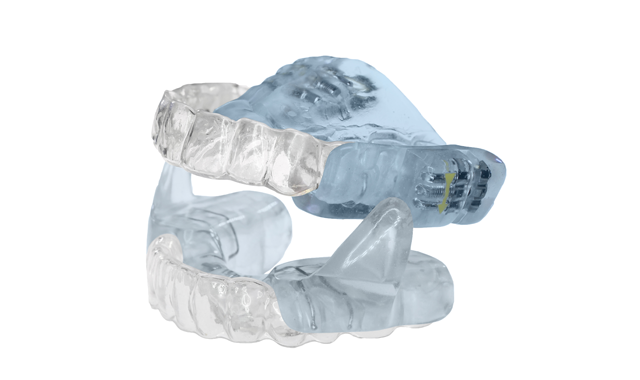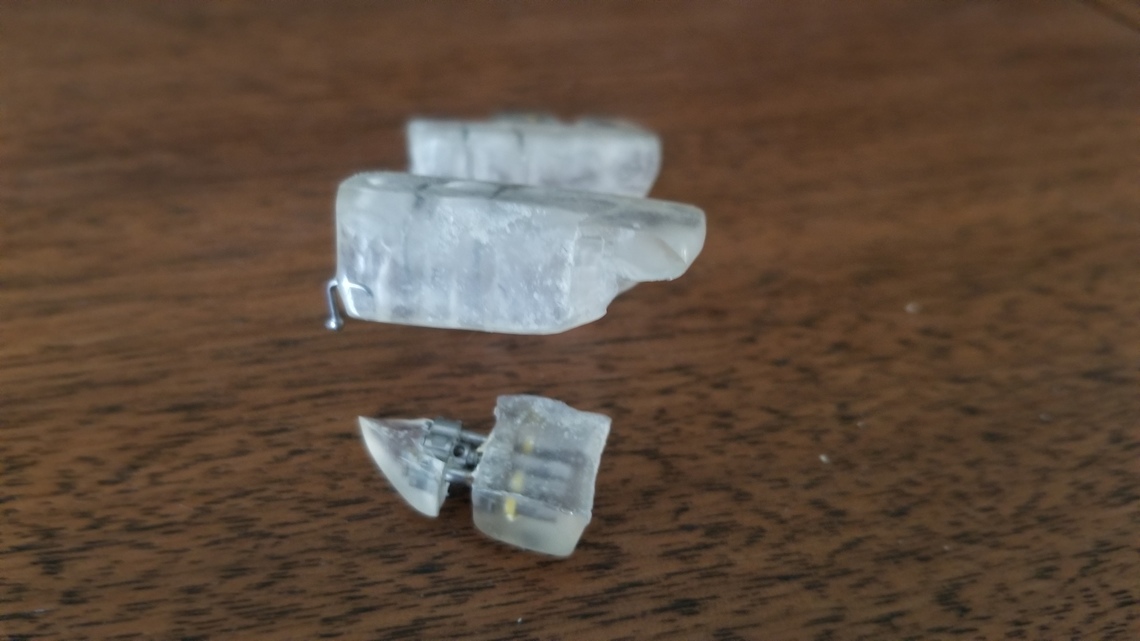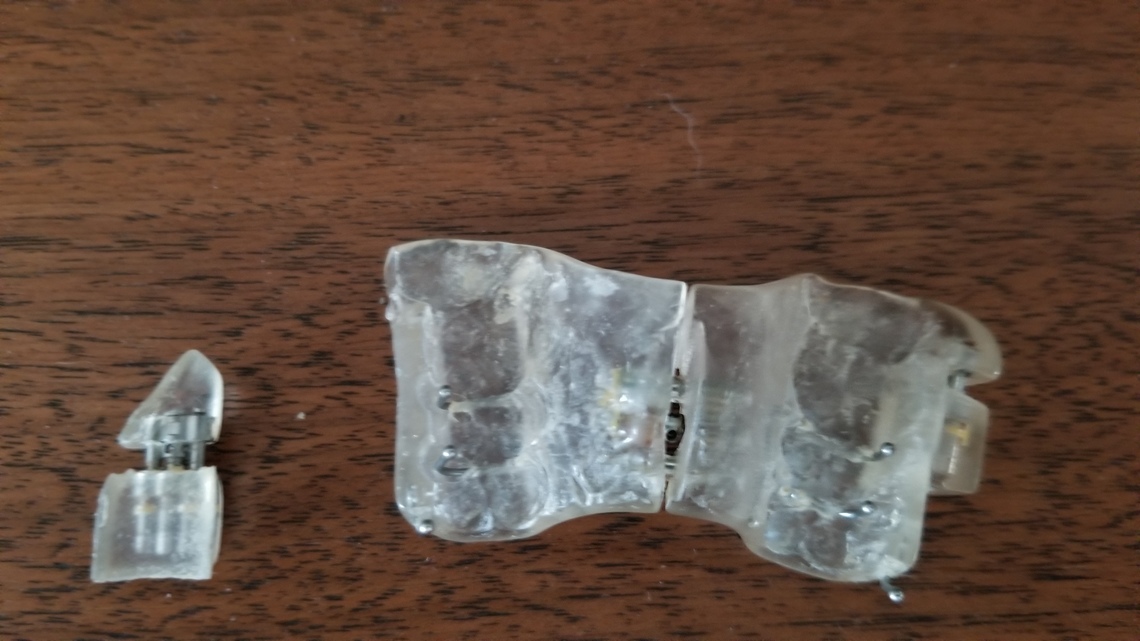A lot of acronyms right? I know - welcome to my life. I'm sure all our our lives...
Short Story: Does anyone else use or have used the Aligner Sleep appliance from SML Global? If so, would you message me?
Long Story: I have obstructive sleep apnea (OSA), with my initial sleep lab results showing I had an AHA over 40. I tried CPAP and am one of the people who can not tolerate it. It was a defeating feeling for me to wake up with the mask on the floor. And a doctor who blamed me for psychologically & unconsciously not wanting treatment. It was quite the opposite - I craved treatment and have been an advocate for my care for over eight years, ever since I was diagnosed. Of course that doctor and clinic is in my rear view mirror. I worked with my primary physician to get assessed for a mandibular advancement device (MAD, aka oral appliance) and was a good candidate. I started with the Somnomed device, which pulled my AHIs to about 10 and a much healthier, mindful existence. I won't go into the health insurance side of this which was a bear, though is catching up.
My particular issue is a small mouth coupled with a large tongue. Add to that mix large tonsils as well, which were a 4 on the Brodsky scale. We removed them to see if it would help. While I no longer snore, it did not impact my OSA - which was a likely outcome. I think those here understand snoring isn't necessarily related to OSA, though many of us are loud snorers. We did a lab study with a MAD and without and the results mirrored the study done before the surgery - so no or negligible change. I wouldn't not do it again since i no longer snore.
A couple years ago my dentist suggested I use Invisalign to correct a tooth which was twisted about 30 degrees. I said I would if there was an oral appliance which worked with Invisalign. So I set out on the hunt and eventually found SML Global, who makes the Aligner Sleep Appliance (ASA) which works with Invisalign. It was a long road to get it though, me and my dentist found SML hard to work with. The ASA was new to the market and, while on their web site, had not been officially announced at the time. So, six months later she found a lab which would make them. My dentist has been an advocate for me through this entire process and only not naming since I haven't asked her if I could.
So, I got the ASA and did a sleep study with it in. The results showed it was incredibly effective. My AHI's went down to 3-4, which took me to the next level where I don't experience apnea while sleeping with it in. Unlike CPAP and my other MAD it was markedly effective while I was supine - which was a thrill. The design has a bridge between the upper molars which goes across the upper soft palate. This leaves about a quarter inch of space between the bridge and my soft palate. My guess is my tongue rests against it and leaves an airway open while the jaw advancement keeps my trachea clear. Double duty for the win!
One unexpected win of having the Invisalign done is that part of the process included widening my mouth by pushing the teeth outward on my jaw. I didn't know this was part of the process but self-reported that I didn't seem to have as much of a next-day impact when I fall asleep on the couch without my appliance in. My doctor agreed it was likely the case since widening the oral cavity is known to help improve obstructive sleep apnea. So I requested a referral to a specialist to see how much more we could widen my mouth. And my dentist was on board for updating my Invisalign treatment to maximize the oral cavity. Thankfully, we had already gone about as far as we could - the specialist saying that we could maybe push another mm but it wouldn't have an impact on my OSA. Since every sleep specialist I've seen knew my mouth was too small for my tongue, I don't know why this was never part of my treatment strategy. It was just pure, dumb luck that I discovered it should have been. I will follow-up with a sleep study once the Invisalign is complete so stay tuned.
The problem has been that the Aligner Sleep Appliance breaks, and breaks often. So far not one piece has lasted over a few months. It's either the upper or lower piece, but always one of them. Having gone through two oral appliances before the ASA, I let my dentist know this is unusual and that the material they are using is very brittle. My previous appliances were replaced due to wear rather than having broken. The Aligner Sleep Appliance has broken apart simply by putting it in my mouth. And also while simply adjusting it the side sheered off. The adjusters have also tarnished and become unadjustable. It's unusual and the lab hasn't been very helpful with slow turn-around times and trying to charge me for fixes which should be covered by the SML 3 year warranty.
I want to reach out to the larger community to see if anyone else is using SML Global's Aligner Sleep Appliance and whether they have the same experience. If not, I'd like to use the same lab to get my next ASA replacement. If so, maybe we can work together to see if we can get SML to adjust the material they use to last.

I am a dentist working in dental sleep medicine. Are you aware of whether or not you do sleep bruxing? That is, do you tend to clench or grind your teeth at night? Many people do and are not aware of it. There would be clinical signs of it in your mouth that your dentist could check. Oftentimes these people are the ones that can break oral sleep apnea appliances multiple times. I would direct you to the Luco Hybrid sleep apnea appliance. It is made of super-strong metal construction, has a design very similar to what you are using, and specifically inhibits sleep bruxing. See: www.lucohybridosa.com.. Arthur B. Luisi, Jr., D.M.D., The Naples Center For Dental Sleep Medicine.
Thanks SleepDent for the informed response. Yes, the designs are very similar and I'll look into this model when I finish Invisalign. All that metal gives me some pause though. Heh. I can't tell from the pics if it's creating a space between the upper palate and the appliance or whether it rests on the upper palate. I'm basically looking for one with a "tongue rest" with some space. Do you know the answer?
No, I don't have bruxing symptoms, though it's a good question and see why you would ask. I have been through two other devices which both lasted about three and a half years and were replaced due to normal wear. If bruxing were the cause I would expect those MADs to have had the same issue, or at least some indicator of it.
In contrast, both upper and lower pieces of the Aligner Sleep Appliance have broken at separate times, with each lasting on the order of about 5 months. This results in a lot of time without treatment, which as you can imagine is difficult for me to get through. Based on the great results from the lab sleep study, I had hoped to keep the appliance permanently and get multiple copies of my last Invisalign trays to continue using it. Based on the breakage experience though, I won't be doing that and trying to push my Invisalign faster to get away from these breaks and avoid further treatment downtime. The SML-associated lab moves slowly, on the order of months, in replacing them so I don't feel they are good stewards of my apnea care.
I wish I had information on the plastic composite used across appliances. I've asked my dentist to inquire about the material composite the lab uses and to see if there's something else they can use when casting the molds. But we haven't received a response on that question.
I'm attaching pictures of one of the breaks, which occurred while while advancing the device. The section with the advancement just sheared off in my hand. IMO, this shouldn't happen.


Well, if you got 3.5 years with the other appliances, that would be considered reasonable, average longevity. In all fairness, I have no familiarity with this particular device, but judging from the pictures above, it would seem to be an issue with the particular plastic material they are using. If you happen to be a big, strong man, you would certainly be capable of exerting significant forces on an OA, but they should all be strong enough to take that much force. The design of the Luco Hybrid does have some space between the palatal struts and the palate. It does not rest directly on the palate. Also, the design is open in the upper anterior, so that your tongue can rest against your incisive papilla, where it belongs, without interference from the device. The metal framework is clad in acrylic, so that very little of the metal is actually exposed in the mouth. Getting back to your problem. If I were the company that made the appliance, I would be quite concerned about the situation. I would assume that you are following whatever cleaning instructions you were given to the letter. If a patient is using other methods or cleaning materials on a device than factory spec, you can materially shorten the life of the material. Dr. Luisi
SleepDent - thanks so much for your responses, they've at least let me know I'm potentially on track. I will definitely be looking into the Luco Hybrid when my Invisalign treatments are over.
I'm not sure how to engage with SML Global regarding the materials, they are really resistant to speaking with clients directly and have no end-user support. My dentist has been an advocate in working with the lab, but the lab has been unresponsive whether there could be a materials problem though they are the one's who keep having to replacing it. With the relatively new status of the device, I would think issues would be expected and would be something the lab and company would be looking for and to resolve quickly.
If you hear of anyone with the Aligner Sleep Appliance mandibular advancement device, especially having the same issues, please feel free to link us up. I know I was the first patient in the Northwest to have one, which is why I reached out on this forum since I don't know anyone locally (or regionally) who has one. Much appreciation. Thanks.
On an unrelated topic have you read any comparison studies between the luco hybrid and other devices without this bridge? and whether it impacts AHIs with a statistical significance? In my singular, anecdotal experience my AHIs decreased by about half (from 8-10 AHIs with Somnomed to 3-4 AHIs with ASA). I noticed better sleep immediately when I started using it and the in-lab sleep study mirrored my self-reporting. This sleep study was done with the first Invisalign tray, which does not move your teeth.
I'm sure there are multiple factors involved when comparing lab studies, particularly based on what is causing the individual's OSA. But it would be insightful for those with OSA where the tongue is too large for the cavity whether the over-palate bridge design is a general recommendation for those patients. I imagine there are enough study results out there to compile this data to see whether its significant.
If you need a hand collating this data, I'm happy to help. Based on research surveys published on PubMed, I would exclude at home studies from this research. Research shows they are wildly inaccurate for assessing the degree of apnea. Though same research shows in-home studies are good at determining whether someone has apnea or not. I don't think in-home sleep results have the rigor for this type of assessment.
I do find your story relatively fascinating, so I went to the SML web site and studied it in depth. Here is my feed-back: You have to give SML credit for innovation in designing the ASA, breakage problems or not. However, I do think that there is an inherent problem with the design that could lead to the breakage problems. The invisalign trays, although relatively thin, do have some minimal bulk. SML has the problem of adding the ASA superstructure over the trays without making the whole thing so bulky that patients could not tolerate it. By definition, then, they have to make the ASA thinner gauge than if it didn't have to fit over the existing trays.---- and this could be partially contributory to the breakage problems. So the ASA could be a satisfactory solution for people in Invisaligns, even with the breakage, but I doubt whether it would be a viable solution for you after you are out of the trays. So why the improved performance over your Somnodent? The design is quite conventional and largely similar to the Somnodent. I can't see the reason for the difference in the design which doesn't mean there isn't one. Two things I observed might account for it: 1. Your dental arches are now wider with treatment, which should help the OSA. 2. The SML specs show the ASA is capable of 8mm of protrusion VS. 5mm with the Somnodent. It may be that your better result is due to the fact that you are attaining a higher level of protrusion than before, which can be critical for severe cases. The answer may be to be sure that your next appliance can attain 8mm or more total protrusion. Hope this helps. Dr. Luisi
Hi Neurotony, Wondering if you ever found a solution to this. I am in a very similar situation. Underwent maxillary expansion with Vivos MRNA, but had to stop after 5 months due to extreme headaches. Finishing up expansion with Invisalign now. I could not tolerate cpap so I had relied on oral appliance therapy. And now with the Invisalign, I have not had any treatment for my OSA for months. So my dentist refined my Invisalign by adding rubber bands to wear at night while I sleep. He said it would keep my jaw from sliding back while I sleep. All it has done was keep my jaw extremely clenched which aggravated my bruxism and TMD. I found out about the Aligner Sleep Appliance in a google search, which let me to your post. Have you resolved your situation? I am in pain and exhausted. Any advice or guidance would be extremely appreciated! Thanks. Best, JBA